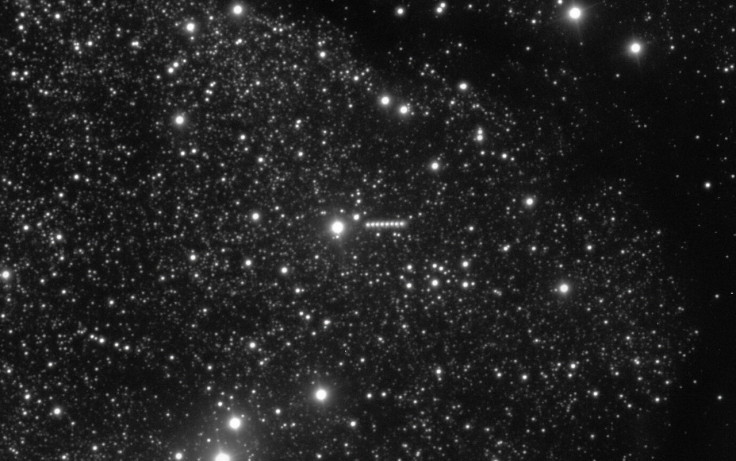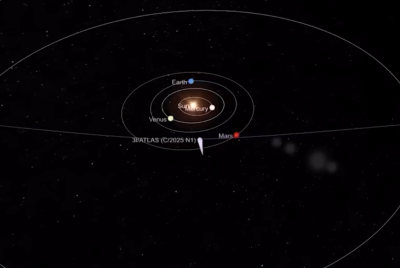NASA Under Fire: Blurry 3I/ATLAS Images Spark Conspiracy Theories
UN drills planetary defenses on 3I/ATLAS. Amateur photos of the interstellar object spark debate vs. NASA's comet theory.

Imagine a mysterious cosmic traveller, streaking through the dark, defying gravity, and causing an international uproar. Now, envision Earth's global planetary defence systems abruptly swinging into action, not because of an impending collision, but for a massive, high-stakes drill focused entirely on this one enigma.
That's precisely what is happening with the interstellar object 3I/ATLAS. The object, officially designated the third known interstellar object to ever visit our Solar System, was first spotted on 1 July 2025 by the NASA-funded Asteroid Terrestrial-impact Last Alert System (ATLAS) telescope in Río Hurtado, Chile.
In a stunning announcement, the United Nations has confirmed that Earth's planetary defences are officially taking aim at 3I/ATLAS in a two-month global campaign. Starting on November 27, a world-class team of scientists will be tracking the supposed comet as it makes its close approach to our planet, reaching its nearest point on December 19.
While the object poses no projected threat, as it will come no closer than about 170 million miles (270 million kilometres) to Earth, the International Asteroid Warning Network (IAWN) is treating this event as an essential, large-scale exercise in case future asteroids are projected to collide with Earth. This preparation is a crucial step in maintaining our planet's cosmic security, even as the nature of the target remains fiercely debated.

Striking Amateur Images Outshine NASA's Blurry Look at 3I/ATLAS
The urgent mobilisation of global resources comes right as new, truly striking images of the visitor have been released, revealing details that NASA's recent shockingly blurry photos did not.
Harvard professor Avi Loeb, a leading proponent of the theory that 3I/ATLAS could be an alien artefact, shared several new images captured by amateur astronomers between November 22 and November 24. These photos — taken by everyday 'skywatchers' using small backyard telescopes in locations like Japan, Spain, and Chile — offered a surprisingly detailed look at the mysterious object.
They revealed a glowing, fuzzy 'head' called a coma, along with a narrow tail stretching over 600,000 miles. Most curiously, the tail was pointing toward the sun instead of away from it like a typical comet. One image even appeared to reveal the specific shape of 3I/ATLAS, showing a cone-like object covered in a bright haze.
In a remarkable turn, these images provided a more detailed look at the mystery object than the sophisticated equipment on board NASA's Mars orbiter.
The space agency, which has maintained that 3I/ATLAS is a comet from a distant solar system, faced heavy criticism following its November 19 press conference. The event was expected to provide the closest look at the object from only 19 million miles away. However, the image from the High Resolution Imaging Science Experiment (HiRISE) camera on board the Mars Reconnaissance Orbiter was a fuzzy, black-and-white picture completely lacking in definition.
HiRISE is the most powerful camera ever sent to another planet, capable of resolving objects on Mars smaller than a metre across. The clearest and most detailed image presented by NASA didn't even show the interstellar object itself; instead, it showed a colour image of the chemical elements being released into space by 3I/ATLAS.
This underwhelming display set off a wave of criticism and conspiracy theories on social media platform X (formerly Twitter), with some alleging the US government was deliberately vague to prevent the public from seeing an 'alien spacecraft'. As one critic posted on X, 'It's amazing how amateur astronomers are producing clearer images than the Never A Straight Answer [NASA] agency'.
The Case for an Extraterrestrial Craft and the Defence Drill of 3I/ATLAS
Professor Loeb has continued to champion the controversial theory that 3I/ATLAS could be an extraterrestrial craft travelling on a specific, non-natural course through our solar system.
The physicist and head of the Galileo Project, a scientific research group looking for signs of extraterrestrial life, has pointed out at least 12 anomalies the object has displayed since its discovery in July, all of which scientists have been unable to explain.
These baffling behaviours include the cometary tail pointing in the 'wrong' direction, the object turning blue near the sun, and a collection of course changes that defy the known laws of gravity.
Meanwhile, while the IAWN, which is operated by the United Nations Office for Outer Space Affairs, will be tracking the object until January as if it were a potential threat, the UN has also officially declared 3I/ATLAS to be 'nothing more than a comet'.
'Comet 3I/ATLAS presents a great opportunity for the IAWN community to perform an observing exercise due to its prolonged observability from Earth and high interest to the scientific community', IAWN wrote in a statement.
Telescopes and tracking systems around the world will focus on the object to refine methods for pinpointing its exact location in the sky. However, despite assurances from both NASA and the UN that the object is merely a comet and that the activation of Earth's planetary defences is only part of a 'normal drill,' some sceptics online remain unconvinced.
'When every telescope from Mauna Kea to Chile is being synced on one object, that's not a drill', one X user posted, suggesting a deeper secret behind the extraordinary measures.
The spectacle of 3I/ATLAS is more than just a passing cosmic event; it's a critical stress test for global planetary defence and a scientific flashpoint that could redefine our place in the Universe.
While official bodies classify it as a comet, the ongoing anomalies, detailed by amateur astronomers and championed by Professor Avi Loeb, fuel an irresistible debate: Is this a benign interstellar chunk of ice, or the ultimate evidence of an extraterrestrial civilisation?
The world's telescopes are now locked on the object until January. This is a scientific drama unfolding in real-time, one that demands our attention.
© Copyright IBTimes 2025. All rights reserved.





















